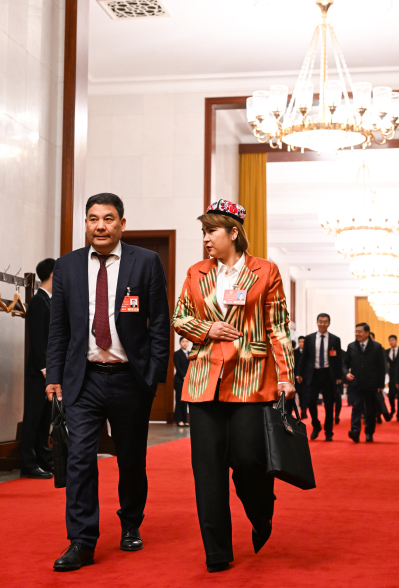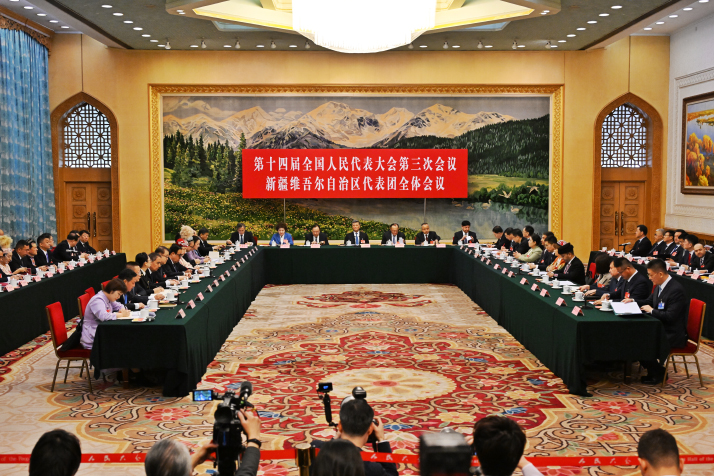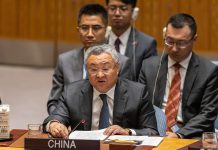
The Two Sessions—the annual gatherings of China’s top legislature, the National People’s Congress (NPC), and the top political advisory body, the National Committee of the Chinese People’s Political Consultative Conference (CPPCC), which were held in Beijing from March 4 to 11—were not only a significant moment in China’s development process but also an important opportunity for Xinjiang Uygur Autonomous Region to embark on a new journey. During the sessions, national lawmakers and political advisors shared their comments on and suggestions for Xinjiang’s development, all the while serving the country’s overall progress via localized initiatives. Xinjiang Today reporter Xu Bei spoke to some of them and summarized their views:

High-quality energy development
“Energy security affects a nation’s economic and social development landscape. Xinjiang, with its abundant energy resources and immense development potential, holds an important position in China’s energy sector,” said Nurlan Abdumanjin, a member of the CPPCC National Committee and Chairman of the CPPCC Xinjiang Uygur Autonomous Regional Committee. In recent years, Xinjiang has capitalized on its rich wind and solar energy resources, dynamically promoting new-energy projects. Its once barren desert areas have now become new-energy development hubs.
He suggested Xinjiang take the lead in developing a national pilot zone for a new-energy system. He proposed measures such as improving the green electricity consumption mechanism, turning more industrial parks into zero-carbon ones, establishing an emergency response mechanism for new-energy storage, promoting mid- and long-term electricity market development, and modernizing the coal market. These efforts would provide a “Xinjiang model” for China’s new-energy system.
Ma Huadong, a member of the CPPCC National Committee and Chairman of the Xinjiang Uygur Autonomous Regional Committee of the China National Democratic Construction Association, focused on increasing oil and gas exploration and production. He proposed easing restrictions on oil and gas mining rights, establishing a paid public service mechanism for sharing oil and gas exploration data, and increasing technological and financial support to achieve breakthroughs in Xinjiang’s resource exploration.
“Xinjiang is home to vast oil and gas reserves, yet their proven and developed portion is less than 20 percent of the total,” Ma noted. “By leveraging these resources, we can achieve rapid increases in oil and gas production, and accelerate the construction of a national energy base, to make greater contributions to ensuring China’s energy security,” he said.

Agricultural giant
“With an exceptional natural environment, Xinjiang produces many distinctive agricultural and livestock products. Whether it’s the sweet and juicy fresh fruits, nutrient-rich dried fruits or the tender and flavorful beef and mutton, they are all favored by consumers nationwide,” said Ma Yanan, an NPC deputy and veterinarian at the Agricultural Product Quality and Safety Center of Changji Hui Autonomous Prefecture.
According to Zheng Yufeng, an NPC deputy and Chairman of the Xinjiang Rural Credit Union, Xinjiang’s agricultural achievements in 2024 can be summarized with four key phrases: a major cotton producer, a granary in west China, the land of fruits and an emerging inland seafood hub.
In 2024, Xinjiang’s total cotton output reached 5.686 million tons, accounting for 92.2 percent of the national total. Its grain production increased by 2.11 million tons last year, making last year the third consecutive year of growth since 2022, bringing the total grain output to 23.3 million tons, ranking 13th nationwide. Also, the region’s abundant sunlight, vast land and diverse soils contribute to a thriving fruit industry, with a total production of 14 million tons in the same year. Though far from the sea, the region is raising seafood such as salmon, grouper and blue crabs with the help of the artificial seawater technology. In 2024, Xinjiang’s aquatic product output reached 196,500 tons, ranking first among the five northwestern provinces and regions.
According to Zheng, this year the region should focus on efficient water and land management to lay a solid foundation for growth in the agricultural sector. Strengthening technology application will be key to modernizing and upgrading the industry, shifting Xinjiang’s agricultural sector from traditional farming to a more high-quality, technology-driven model.
Xinjiang has set ambitious targets for 2025. They include: increasing grain production by at least 500,000 tons, ensuring that more Xinjiang-grown grain contributes to the country’s food security; keeping cotton production stable at over 5 million tons, further strengthening the industry’s competitiveness; establishing a modern agricultural industrial system; and diversifying food production to meet nationwide demand to ensure Xinjiang plays a key role in securing China’s food supply.
Combating desertification
China still faces severe desertification challenges, making land degradation one of the country’s most pressing ecological issues. As desertification control progresses, new challenges and tasks arise. The Taklimakan Desert, located in the center of the Tarim Basin in south Xinjiang, is the largest desert in China. Desertification prevention and control have long been a priority in the region.
After four decades of efforts, a 2,761-km green belt has been planted along the edge of the Taklimakan Desert. “Xinjiang has demonstrated its knowhow and perseverance in creating a ‘green miracle,’ contributing valuable Chinese experience to global desertification control,” said NPC deputy Mahmut Omarjan, Deputy Secretary of the Communist Party of China Hetian (Hotan) Prefectural Committee.
Desertification control is not merely an environmental task, but also plays an important role in improving people’s living standards. According to Mahimut, Hetian Prefecture has adopted a localized and adaptive multi-pronged approach to effectively tackle desertification. He said, “Xinjiang has combined ecological management with industrial development, launching multiple projects ranging from specialized livestock farming to fruit tree cultivation and desert tourism.” One example is the cultivation of Cistanche deserticola, a valuable medicinal herb that thrives in desert conditions. “By integrating these types of industries into the local economy, residents can increase their income while contributing to environmental conservation,” he added.
Attracting talent
Liu Hongtao is an NPC deputy and executive vice general manager of PetroChina Coalbed Methane Co. Ltd. He focused on technology and talent development in Xinjiang.
Having worked in the Tarim Oilfield for over a decade, Liu has witnessed Xinjiang’s technological progress firsthand. In February 2025, Xinjiang finished drilling Asia’s first 10,000-meter-deep vertical well in the Tarim Basin, marking another major breakthrough in China’s “deep Earth” exploration. Xinjiang’s oil and gas production reached 66.64 million tons in 2024, maintaining its position as the nation’s top producer and making a substantial contribution to national energy security. With further breakthroughs in exploring deep-seated oil and gas, as well as coalbed methane, Xinjiang is expected to play a greater role in ensuring China’s energy security.
Also, Xinjiang has implemented major initiatives to drive innovation, including launching a 10-billion-yuan ($1.4-billion) Talent Development Fund and a program to attract top researchers, building multiple research platforms with multiple ministries’ support, introducing policies to improve services for researchers in aspects like housing, children education and spousal employment.
These combined efforts have propelled Xinjiang’s technological progress at an accelerated pace. In 2024, its research and development expenditure reached 11.55 billion yuan ($1.5 billion), and the number of hi-tech enterprises rose to 2,529. Xinjiang’s regional innovation ranking improved from 30th place to 27th nationwide.
“Xinjiang will provide an open and free research environment for those who are highly talented, allowing them to realize their dreams,” Liu said.
Connecting the world
Li Lan, an NPC deputy and Director of the Tech Center of Alashankou (Alataw) Customs, has been dedicated to promoting opening up. Alashankou is a major port of entry on the Kazakhstan border. She has provided advice on optimizing the port’s business environment, enhancing customs clearance efficiency, and improving port laboratory testing capabilities. She said she will continue to offer policy recommendations for high-quality port development, so as to help facilitate deeper and more substantive cooperation under the Belt and Road Initiative, a China-proposed initiative to boost connectivity along and beyond the ancient Silk Road routes. –The Daily Mail-Beijing Review news exchange item





